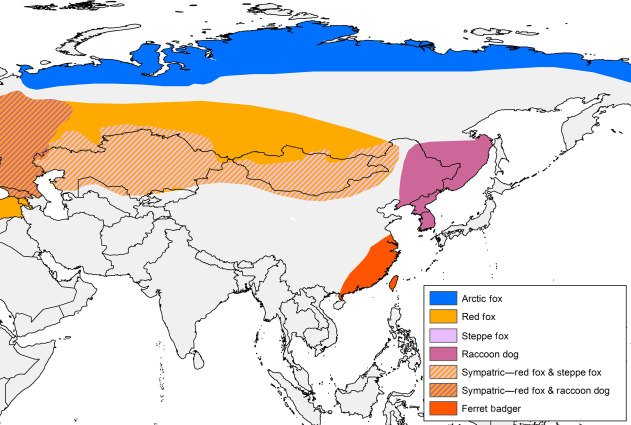
Family Canidae
Canidae (from Latin, canis, "dog") is a biological family of dog-like carnivorans, colloquially referred to as dogs, and constitutes a clade. A member of this family is also called a canid. There are three subfamilies found within the canid family, which are the extinct Borophaginae and Hesperocyoninae, and the extant Caninae. The Caninae are known as canines, and include domestic dogs, wolves, foxes, jackals and other extant and extinct species.
Canids are found on all continents except Antarctica, having arrived independently or accompanied human beings over extended periods of time. Canids vary in size from the 2-metre-long (6.6 ft) gray wolf to the 24-centimetre-long (9.4 in) fennec fox. The body forms of canids are similar, typically having long muzzles, upright ears, teeth adapted for cracking bones and slicing flesh, long legs, and bushy tails. They are mostly social animals, living together in family units or small groups and behaving cooperatively. Typically, only the dominant pair in a group breeds, and a litter of young are reared annually in an underground den. Canids communicate by scent signals and vocalizations. One canid, the domestic dog, originated from a symbiotic relationship with Upper Paleolithic humans and today remains one of the most widely kept domestic animals.
Simply check the links to visit my galleries for each genus. In some cases, I will combine taxa on one page when I have smaller collections of images.
Tibetan Wolf (Canis lupus chanco)
Himalayan Wolf (Canis lupus himalayensis)
Arabian Wolf (Canis lupis arabs) Captive & Wild
Mearn's Coyote (Canis latrans mearnsi)
Plains Coyote (Canis latrans latrans)
Peninsular or Mexican Coyote (Canis latrans peninsulae)
Northwestern Coyote (Canis latrans umpquensis)
Northern or Western Coyote (Canis latrans incolatus)
Northern African Wolf (Canis lupaster lupaster)
Southern Ethiopian Wolf (Canis simensis citernii)
Northern Ethiopian Wolf (Canis simensis simensis)
Indochinese Golden Jackal (Canis aureus cruesemanni)
Sri Lankan Golden Jackal (Canis aureus naria)
Indian Golden Jackal (Canis aureus indicus)
Persian Golden Jackal (Canis aureus aureus)
Dingo (Canis familiaris dingo) Lakeland Savanna Biome Region - Queensland
Tribe Canini (cont’d)
Cuon alpinus (Dhole)
Lycaon pictus (African Wild Dog)
Lupulella adusta (Side-striped Jackal)
Lupulella mesomelas (Black-backed Jackal)
South American Canini
Lycalopex culpaeus (Culpeo or Andean Fox)
Cerdocyon thous (Crab-eating Fox)
Urocyon cinereoargenteus (Gray Fox)
Urocyon littoralis (Island Fox)
Chrysocyon brachyurus (Maned Wolf)
Maned Wolf (Chrysocyon brachyurus)
Indochinese Dhole (Cuon alpinus infuscus)
Andean Wolf of Culpeo (Lycalopex culpae)
Cape Black-backed Jackal (Lupulella mesomelas mesomelas)
Crab-eating Fox (Cerdocyon thous)
Island Fox (Urocyon littoralis)
South African Wild Dog (Lycaon pictus pictus)
Kaffa Side-striped Jackal (Lupulella adustus kaffensis)
East African Black-backed Jackal (Lupulella mesomelas schmidti)
Yucatan Gray Fox (Urocyon cinereoargenteus fraterculus)
Tibetan Fox (Vulpes ferrilata)
Bering Island Arctic Fox (Vulpes lagopus beringensis)
Iceland or Spitzbergen Arctic Fox (Vulpes lagopus fuliginosus (SPITZBERGEN V.l. spitzbergensis)
American Red Fox (Vulpes vulpes fulva)
Iberian Red Fox (Vulpes vulpes silacea)
Karagan or Xinjiang Red Fox (Vulpes vulpes karagan)
Hokkaido Red Fox (Vulpes vulpes schrencki)
Tibetan Red Fox (Vulpes vulpes montana)

San Joaquin Kit Fox (Vulpes macrotis mutica)
Alaskan Red Fox (Vulpes fulva alascensis)
Daurian or East Russian Red Fox (Vulpes vulpes daurica)

Peninsular Kit Fox (Vulpes macrotis macrotis)
Cape Fox (Vulpes chama)
Fennec Fox (Vulpes zerda)
Bat-eared Fox (Otocyon megalotis megalotis)









































